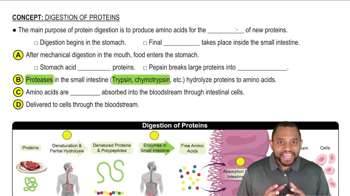For each of the following proteins, note whether the main secondary structure feature is α helix, β-pleated sheet, or both.
a. collagen
 Verified step by step guidance
Verified step by step guidance Verified video answer for a similar problem:
Verified video answer for a similar problem:



 1:5m
1:5mMaster Secondary Protein Structure Concept 1 with a bite sized video explanation from Jules
Start learning